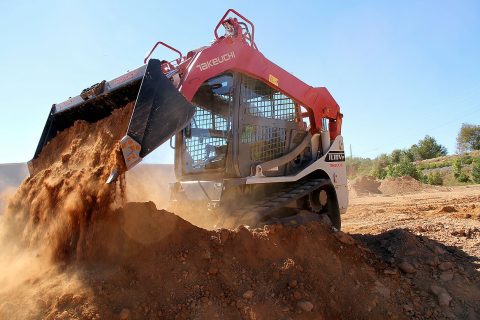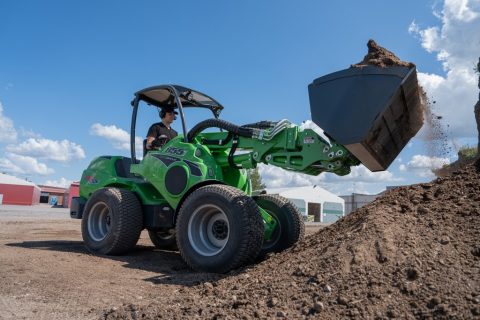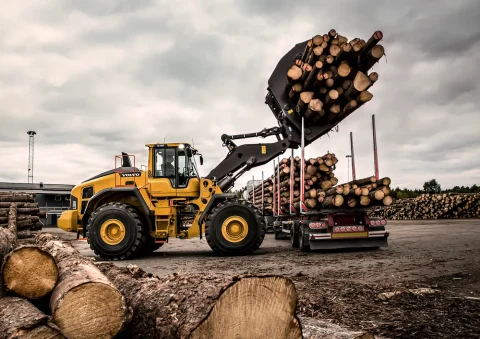Wheel Loaders vs. Track Loaders
Key Takeaways:
Wheel loaders and track loaders are essential pieces of heavy equipment used for material handling, grading, and site preparation. The main difference lies in their mobility, traction, and surface compatibility. Wheel loaders excel on paved or hard-packed surfaces with faster travel speeds and lower fuel costs, while track loaders perform better on soft, muddy, or uneven terrain where traction and stability are key. Choosing the right loader depends on jobsite conditions, maintenance preferences, and overall operating costs.
Whether you’re managing a construction site, landscaping operation, or material yard, choosing between a wheel loader and a track loader can significantly impact productivity and cost efficiency. Both machines are designed for lifting, loading and transporting materials, but they perform differently based on ground conditions, terrain type and the specific demands of your operation.
Understanding how each of these machines work, their strengths and weaknesses, and their ideal use cases can help you make an informed decision that minimizes downtime, reduces wear and tear, and optimizes fuel efficiency.
What Are Wheel Loaders?
Wheel loaders are versatile machines equipped with four rubber tires and a large front bucket designed for scooping and loading materials. They are commonly used in construction, roadwork, agriculture and snow removal operations.
The tires allow wheel loaders to travel quickly between work areas, making them highly efficient for jobs that require frequent movement or transport over paved or compacted ground. They’re also known for their relatively smooth ride, making them ideal for operators working long shifts.
Key advantages of wheel loaders include:
- Speed and mobility – Faster travel speeds reduce cycle times on large jobsites
- Lower fuel consumption – Wheels create less rolling resistance than tracks
- Reduced surface damage – Ideal for asphalt, concrete, and other hard surfaces
- Ease of maintenance –Tires are easier and less expensive to replace than tracks
Wheel loaders come in a range of sizes, from compact loaders for landscaping and municipal work to large, heavy-duty machines for quarry or mining operations.
Learn more: Top Wheel Loader Features that Improve Operator Productivity
What Are Track Loaders?
 Track loaders combine the power and versatility of a wheel loader with the traction of a crawler machine. Instead of tires, they use a continuous rubber or steel track system that distributes the machine’s weight more evenly across the ground.
Track loaders combine the power and versatility of a wheel loader with the traction of a crawler machine. Instead of tires, they use a continuous rubber or steel track system that distributes the machine’s weight more evenly across the ground.
This design gives track loaders superior traction and flotation on soft, uneven or muddy surfaces where wheeled equipment might sink or slip. They’re widely used in grading, excavation, forestry, site development and other areas with challenging terrain or wet conditions.
Key advantages of track loaders include:
- Superior traction and stability – Perform well on slopes, mud or loose soil
- Lower ground pressure – Reduces surface damage in sensitive environments
- Versatile operation – Can push, lift and dig in conditions unsuitable for wheels
- Enhanced pushing power – Better suited for heavy material movement and grading
Track loaders are often chosen for their all-terrain capability, but that added traction comes with tradeoffs in speed, fuel efficiency and maintenance costs.
Best Jobs for Wheel Loaders vs. Track Loaders
The best way to decide which type of loader fits your operation is to match the machine to your typical work environment and task requirements.
Wheel loaders excel in:
- Asphalt or concrete plants
- Snow removal and road maintenance applications
- Material handling in yards or warehouses
- Construction projects on compacted soil
- Agriculture and bulk material movement
Track loaders excel in:
- Site grading and land clearing applications
- Forestry and logging operations
- Excavation on uneven or wet terrain
- Landscaping and site prep on soft ground
- Trenching, digging or backfilling in muddy conditions
In general, if your job involves frequent travel across hard surfaces or long-distance movement between sites, a wheel loader will perform better. If your work demands maximum traction, ground stability or operation on slopes, a track loader is the better investment.
Fuel and Operating Cost Comparison Between Wheel and Track Loaders
Fuel efficiency and overall operating costs play a significant role in total ownership cost. Understanding the differences in these costs will help you to more effectively evaluate which type of loader represents the better investment for your business.
Wheel loaders tend to consume less fuel due to lower rolling resistance. Their tires offer better energy transfer on firm ground, and their higher travel speeds reduce idle time between cycles. Maintenance and tire replacement costs are also typically lower than the ongoing expenses of track maintenance.
Track loaders, on the other hand, use more fuel due to increased friction from the tracks and the heavier undercarriage. Track systems also wear faster on hard surfaces, increasing maintenance costs over time. Replacement of a full track system is considerably more expensive than replacing tires.
If you operate primarily on hard surfaces or in areas requiring long travel distances, a wheel loader’s efficiency and lower maintenance requirements often result in lower total operating costs.
How Ground Conditions Affect Loader Choice
 Ground conditions are often the deciding factor between wheel and track loaders:
Ground conditions are often the deciding factor between wheel and track loaders:
- Firm, paved or compacted soil – Wheel loaders provide better performance, faster travel and less surface wear
- Soft, wet or loose terrain – Track loaders distribute weight evenly, reducing ground pressure and preventing the machine from sinking
- Sloped or uneven surfaces – Track loaders offer more traction and stability, reducing the risk of slippage or tipping
- Urban or sensitive environments – Wheel loaders are preferred for minimizing ground disruption and noise
If your jobsite conditions change seasonally, such as due to muddy spring months or snow in the winter, you may want to consider carrying both types of loaders to maintain the year-round flexibility required by your varying work conditions.
Maintenance Differences and Common Repair Issues
Maintenance needs vary significantly between the two types of loaders.
Wheel loaders:
- Require regular tire inspection and inflation checks
- Experience faster wear on tires if used on abrasive surfaces
- Have simpler undercarriages, making servicing quicker and more affordable
- Commonly experience issues such as hydraulic leaks, worn bucket pins or tire punctures
Track loaders:
- Need frequent undercarriage cleaning, especially after operating in mud or gravel
- Require track tension to be checked regularly to prevent excessive wear
- Have more moving parts (rollers, sprockets, idlers) that increase maintenance complexity
- Commonly experience issues such as track wear, roller failure and material buildup
Proper preventive maintenance, including cleaning, lubrication and scheduled inspections, can extend the lifespan and minimize downtime of either loader.
Transport and Storage Requirements for Each Loader
Wheel loaders are easier to transport since they can travel short distances on public roads at higher speeds. Their tires are less likely to damage pavement, and they can be driven onto trailers without special equipment. Storage requires less cleaning and preparation since there’s no undercarriage buildup to manage.
Since track loaders are heavier and slower, they typically require hauling via lowboy trailer or flatbed truck. They should be cleaned before transport to remove mud or debris that could dislodge in transit. When stored, they benefit from being kept on solid, dry surfaces to prevent track rust or deformation.
For businesses managing multiple sites or frequent relocations, wheel loaders often offer lower transport and logistics costs.
Which Option Is Right for Me?
 Choosing between a wheel loader and a track loader comes down to your terrain, workload and long-term cost considerations. Wheel loaders deliver efficiency, speed and lower maintenance on hard surfaces, while track loaders provide superior traction, stability, and performance on soft or uneven ground.
Choosing between a wheel loader and a track loader comes down to your terrain, workload and long-term cost considerations. Wheel loaders deliver efficiency, speed and lower maintenance on hard surfaces, while track loaders provide superior traction, stability, and performance on soft or uneven ground.
For the most cost-effective approach, evaluate where your equipment spends most of its time and what types of tasks it performs most often. Many successful operations maintain a balanced fleet that includes both types, ensuring maximum productivity across diverse job conditions.
McClung-Logan Can Help
If you’re considering upgrading your fleet of loaders, McClung-Logan can help you choose between wheel and track loaders. We’ve been the leading heavy equipment dealer in the Mid-Atlantic region since 1939. Our comprehensive line of new and used wheel loaders and track loaders ensures we’ll be able to provide you with the right equipment for your specific needs and applications. We also have an extensive rental fleet if owning your machinery doesn’t align with your budget.
Our inventory includes the latest models of wheel loaders and track loaders from some of the leading brands in the industry, including:
You’ll also benefit from our Simply Done Right Service™ Pledge to make your business more profitable. Our exclusive pledge provides you with:
- 24/7 assistance
- A highly trained service team
- Communication in your preferred method (text, phone, email)
- Extensive inventory on hand to ensure you receive any parts you need as quickly as possible
Contact one of our branch locations to speak with a sales representative. McClung-Logan is a full-service heavy equipment dealer serving the Mid-Atlantic Region.
